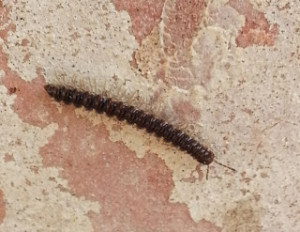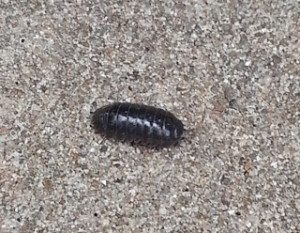By Wizzie Brown
I’m loving the rain we’ve been getting in Central Texas, but it has been leading to some pest problems that people haven’t really had to deal with for a while. I thought that I would touch on some of them.
The first and foremost for me are millipedes. Yesterday afternoon when it was raining, I took the opportunity to head outside to look for millipedes for photos. I could not find a single one. While disappointed, I knew that I had seen some at home so I figured I could get my photo there. When I got home I was starving so I started making dinner. In the middle of cooking bacon (it was a breakfast for dinner night), I was looking around the kitchen and spotted a millipede walking across the ceiling. Instead of climbing on the counter to take a picture, I went outside and found plenty to photograph. After that, I proceeded to pick up about 30 millipedes in various areas of the house.
 Millipedes have long, worm-like bodies with a single pair of antenna. Their body is cylindrical and usually brown in color. Millipedes have two pairs of legs per body segment and often curl into a spiral for protection or when they die. They feed on decaying organic matter, though some are carnivorous.
Millipedes have long, worm-like bodies with a single pair of antenna. Their body is cylindrical and usually brown in color. Millipedes have two pairs of legs per body segment and often curl into a spiral for protection or when they die. They feed on decaying organic matter, though some are carnivorous.
 Pillbugs are the other big one that can venture inside when we have heavy rains. Sowbugs and pillbugs are crustaceans (related to crabs, crayfish and lobsters). They require moist environments and usually die quickly when they move indoors due to lack of moisture. Sowbugs and pillbugs have oval shaped bodies, 7 pairs of legs and 2 pair of antennae (only one pair is easily visible). Sowbugs have two tail-like appendages that come off the tip of the abdomen. Pillbugs do not have a tail-like appendage and pillbugs can also roll up into a ball when disturbed (hence the name roly-poly).
Pillbugs are the other big one that can venture inside when we have heavy rains. Sowbugs and pillbugs are crustaceans (related to crabs, crayfish and lobsters). They require moist environments and usually die quickly when they move indoors due to lack of moisture. Sowbugs and pillbugs have oval shaped bodies, 7 pairs of legs and 2 pair of antennae (only one pair is easily visible). Sowbugs have two tail-like appendages that come off the tip of the abdomen. Pillbugs do not have a tail-like appendage and pillbugs can also roll up into a ball when disturbed (hence the name roly-poly).
Another nuisance pest I should mention is amphipods, also known as scuds. Calls that I get on these critters are when they have already died inside the home. Living amphipods are yellowish-brown in color and live in moist areas like under mulch or groundcover. When we get heavy rain, they can move indoors where they die from lack of moisture. When the amphipods die, their body turns a reddish-pink color (these are also a crustacean and closely related to shrimp). You can find more on amphipods here.
If you are having problems with these nuisance pests moving indoors, then you should focus on the outside of the structure to exclude them. Once things dry out then it should go back to normal.
- turn mulch often; adjust watering schedules
- remove any debris laying near structures or areas you do not want pests
- allow air to flow through crawl spaces by using the proper amount of ventilation
- fix any leaking faucets, AC lines, water pipes, etc.
- make sure gutters and drains carry water away from the structure
- make sure doors and windows have a proper seal; replace weather stripping, thresh holds, etc.
- apply sealant to any cracks & crevices and to where pipes or wires penetrate the building
If you are having a mass invasion of pillbugs outside and they are eating your plants (it doesn’t happen too often, but conditions are ripe for this right now), then you can try making traps. I still need to test out what specifically works, but I’m sure you can search for ideas. If you feel you need to treat for the pillbugs, make sure that you check the product label so you choose a product with pillbugs and sowbugs on the label. There are snail & slug baits that also can work on pillbugs and sowbugs, but not ALL snail & slug baits control them. You could also treat with a contact pesticide. Unfortunately, while those products could work, they should not be applied when it is raining or there is a chance of rain, so pesticides are currently out as an option.

 .
.